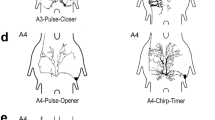Summary
-
1.
We found no evidence that the thoracic ganglia which effect locomotory movements are themselves autonomously (circadian) rhythmic in their activity.
-
2.
The abdominal ganglia play no role in effecting the rhythmicity of the thoracic ganglia, and hence, of locomotion.
-
3.
We found positive evidence that the suboesophageal ganglion does not control the locomotory rhythm by a rhythmic secretion of a hormonal agent. It does, on the other hand, control activity level by a neural channel.
-
4.
The evidence is strong that the driving oscillation is in the brain, in fact in the protocerebrum.
-
5.
The pars intercerebralis suppresses (by a hormonal channel) the level of activity. It also, and separately, mediates locomotory activity by a hormonal channel.
-
6.
The pars intercerebralis can however only cause rhythmicity of locomotion when it has intact neural connections with the optic lobes.
-
7.
The driving oscillation in the nervous system responsible for the circadian rhythm of locomotory activity is thus — probably — localized in the optic lobes.
-
8.
Animals in which the left optic tract and the right optic nerve have been severed display a freerunning rhythm in a 24 hour light/dark cycle: the driving oscillation in the left optic lobe is uncoupled from the pars intercerebralis which it therefore cannot drive; the oscillation in the right optic lobe can drive the pars intercerebralis but is uncoupled from the right compound eye.
Zusammenfassung
-
1.
Wir fanden keinen Anhaltspunkt dafür, daß die Thorakalganglien, die die lokomotorische Aktivität beeinflussen, eine eigene autonome (circadiane) Rhythmik ihrer Aktivität besitzen.
-
2.
Die Abdominalganglien spielen keine Rolle bei der Beeinflussung der Rhythmik der Thorakalganglien — und damit der Lokomotion.
-
3.
Wir konnten zeigen, daß das Suboesophagalganglion die Bewegungsrhythmik nicht durch rhythmische Sekretion eines hormonalen Stoffes steuert. Es kontrolliert dagegen die Stärke der Aktivität auf nervösem Wege.
-
4.
Starke Anhaltspunkte sprechen dafür, daß der steuernde Oszillator im Gehirn liegt, und zwar im Protecerebrum.
-
5.
Die Pars intercerebralis erniedrigt (auf hormonalem Wege) die Aktivität. Sie bewirkt ebenfalls — getrennt davon — lokomotorische Aktivität auf hormonalem Wege.
-
6.
Die Pars intercerebralis kann jedoch nur dann eine Bewegungsrhythmik bewirken, wenn die nervösen Verbindungen mit den optischen Lappen intakt sind.
-
7.
Der für die circadiane Rhythmik der Bewegungsaktivität verantwortliehe steuernde Oscillator im Nervensystem ist deshalb wahrscheinlich in den optischen Lappen lokalisiert.
-
8.
Tiere, deren linke optische Bahnen und rechte optische Nerven durchtrennt waren, zeigen eine freilaufende Rhythmik im 24 Std-Licht-Dunkel-Zyklus: Der steuernde Oscillator im linken optischen Lappen ist von der Pars intercerebralis entkoppelt, und er kann sie deshalb nicht steuern; der Oscillator im rechten optischen Lappen kann zwar die Pars intercerebralis steuern, aber er ist vom rechten Komplexauge entkoppelt.
Similar content being viewed by others
References
Brady, J.: Control of the circadian rhythm of activity in the cockroach. I. The role of the corpora cardiaca, brain and stress. J. exp. Biol. 47, 153–163 (1967a).
—: Control of the circadian rhythm of activity in the cockroach. II. The role of the suboesophageal ganglion and ventral nerve cord. J. exp. Biol. 47, 165–178 (1967b).
Cameron, E.: The cockroach. London: William Heinemann, Medical Books Ltd. 1961.
Eidman, H.: Über rhythmische Erscheinungen bei der Stabheuschrecke Carausius morosus. Z. vergl. Physiol. 38, 370–390 (1956).
Harker, J. E.: Factors controlling the diurnal rhythm of activity in Periplaneta americana. J. exp. Biol. 33, 224–234 (1965).
—: The effect of perturbations in the environmental cycle of the diurnal rhythm of activity of Periplaneta americana L. J. exp. Biol. 37, 154–163 (1960a).
—: Internal factors controlling the suboesophageal ganglion neurosecretory cycle in Periplaneta americana L. J. exp. Biol. 37, 164–170 (1960b).
Nishiitsutsuji-Uwo, J., S. F. Petropulos, and C. S. Pittendrigh: Central nervous system control of circadian rhythmicity in the cockroach. I. Role of the pars intercerebralis. Biol. Bull. Wood's Hole (in press) (1967a).
—, and C. S. Pittendrigh: Neuroendocrine basis of midgut tumor induction in cockroaches. J. Insect Physiol. 13, 851–859 (1967b).
- - Central nervous system control of circadian rhythmicity in the cockroach. II. The pathway of light signals that entrain the rhythm. Submitted to Z. vergl. Physiol. (1968).
Roberts, S. K.: Significance of endocrines and central nervous system in circadian rhythms. In: Circadian Clocks (ed. J. Aschoff), p. 198–213. Amsterdam: North Holland Publishing Co. 1965.
Scharrer, B.: Neurosecretion. XI. The effects of nerve section on the intercerebralis-cardiacum-allatum system of the insect Leucophaea madeirae. Biol. Bull. Wood's Hole 102, 261–272 (1952).
Strumwasser, F.: The demonstration and manipulation of a circadian rhythm in a single neuron. In: Circadian Clocks (ed. J. Aschoff), p. 442–462. Amsterdam: North-Holland Publishing Co. 1965.
Author information
Authors and Affiliations
Additional information
The work reported in this paper was performed under contracts (Nas-223) with the National Aeronautics and Space Administration and the Air Force Office of Scientific Research (AP-F44620-67-C-0025).
Rights and permissions
About this article
Cite this article
Nishiitsutsuji-Uwo, J., Pittendrigh, C.S. Central nervous system control of circadian rhythmicity in the cockroach. Z. Vergl. Physiol. 58, 14–46 (1968). https://doi.org/10.1007/BF00302434
Received:
Issue Date:
DOI: https://doi.org/10.1007/BF00302434




